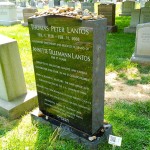The world’s largest outdoor encyclopedia is in DC

Grave of Representative Tom Lantos at the Congressional Cemetery, Washington, DC. Note the QR code.
Creative Commons Attribution-Share Alike 3.0 Unported license under Peter Ekman.
All the world’s a stage, and every prop, scene, and player conceals a story. On the way to work we pass by some statue or fountain that once tickled the imagination and now sits comfortable and unnoticed in its familiarity, and wonder what story lies behind it. Passing an eccentric neighbor’s cubicle and glancing at the sprinkling of medieval portraits adorning its walls, we briefly wonder just who Nostradamus actually was. With leaps in information technology, finding the answer can be as easy as pointing your smart phone at a little card.
Just in the past year QR codes have cropped up on walls and banners, on brochures and menus, linking customers with the appropriate smart phone application to websites about the advertised business or to nutritional facts on a menu’s dishes. Increasingly, institutions such as museums, galleries, and city governments realize the educational potential behind these codes. Wikipedia, with its crowd-sourced articles on millions of topics in hundreds of languages, is the most comprehensive source for articles about pieces of art or the history of a central park. The love child between these institutions and Wikipedia is QRpedia.
Just recently, the 205-year-old Congressional Cemetery became the world’s largest outdoor encyclopedia of American history. Sixty QR codes link visitors to the Wikipedia pages of such diverse people as Congressman Henry Clay, FBI Director J. Edgar Hoover, and Leonard Matlovich, America’s first openly gay serviceman. The Wikimedian behind this effort, Peter Ekman, explained why he chose a cemetery, not exactly the typical GLAM (Galleries, Libraries, Archives, Museums) outreach fare.
“It chose me,” he said. “Everything I wanted to do, the cemetery people were happy to oblige. Most of the article compilation work was already done by anonymous Wikipedians so most of the work was just printing out the codes and putting them up. It is cheap, inexpensive, anybody can do this.”
It took $400 to print out the QR codes, laminate them, and obtain the garden stakes to anchor them into the soil.
“Local groups can do this themselves,” Ekman added. “Once it’s been established that it can be done, historical societies and other locally-oriented groups can see that this gets done.”
While QRpedia is relatively new in the US, many places in Europe have already embraced it. A prominent factor in its success in Europe thus far is that, not only does the code take the smart phone user to the Wikipedia article associated with what they are looking at, it also directs them straight to the article in the phone’s set language. Even if a museum or plaque does not provide information in a visitor’s native tongue a QRpedia code can directly circumvent the informational gap.
The most comprehensive QRpedia project is actually an entire city, the city of Monmouth, Wales, and the project is known as Monmouthpedia. Aiming to cover every single notable place, person, artifact, plant, animal and other item of note in Monmouth in as many languages as possible, but with a special focus on Welsh, this project carpets the city with QR codes. Ekman said that he was inspired by the monumental, ongoing achievement of Monmouthpedia, adding that “if they can do it, so can I, and so can anybody else.”
Visit http://qrpedia.org/ to play around and see how extraordinarily easy it is to create QRpedia codes. The most difficult part for volunteers can be obtaining permission to post the codes, but everything else is a breeze.
Lisa Marrs, Outreach & Program Coordination, Wikimedia DC
July 18th, 2012 at 10:33 AM
[…] The cemetary is 205 years old and is now the world’s largest outdoor encyclopedia of American history. […]